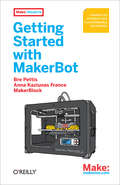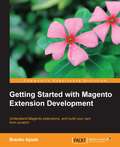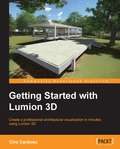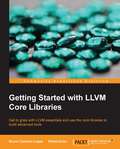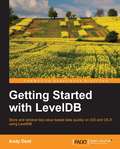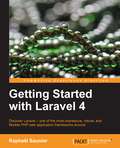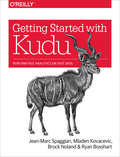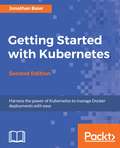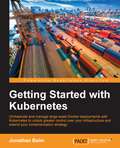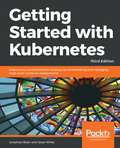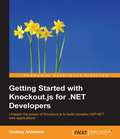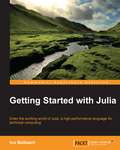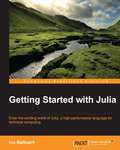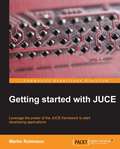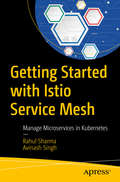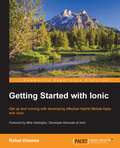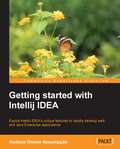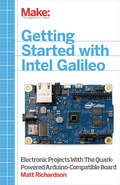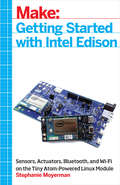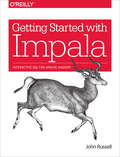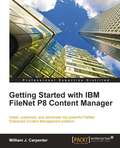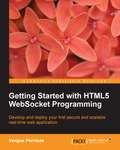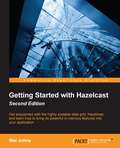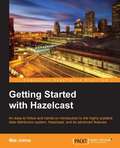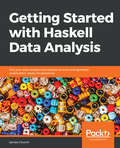- Table View
- List View
Getting Started with MakerBot
by Bre Pettis Jay Shergill Anna Kaziunas FranceReady to join the personal fabrication movement? This hands-on book shows you how to make a wide variety of physical objects with the amazing MakerBot 3D printer. It's handy when you need a replacement for something lost, broken, or no longer made--like a knob on your stove. You can make things instead of buying them, or solve problems with inventions of your own. The possibilities are endless, and MakerBot is the fun, affordable, and inspiring way to go. Get started with your own little factory today! Set up your MakerBot Replicator 2 and understand how it works Learn the basics and print 10 useful objects right away Make objects with sturdy yet biodegradable PLA Get examples of real-world problem solving, from ceiling hooks to hermit crab shells Choose from thousands of free designs on Thingiverse.com--and share your own Repurpose disposable products by making them part of your design Design your own 3D objects, using SketchUp, Autodesk 123D, OpenSCAD, and other tools Use 3D scanning technology to replicate real objects around you
Getting Started with Magento Extension Development
by Branko AjzeleThis project-based tutorial gives you a strong foundation and guides you through practical, real-world examples.This book contains valuable insights for both newbies and already established Magento developers. This book is targeted at new and intermediate PHP developers starting afresh with Magento module development.
Getting Started with Lumion 3D
by Ciro CardosoA beginner's guide which flows from novice level discussion into intermediate level usage and finally helps the experts with tips and tricks."Getting Started with Lumion 3D" is the perfect book for someone without any experience in Lumion and who wants to start performing architectural visualization. It is also ideal for intermediate users who want to improve their workflow and learn techniques to get the best out of Lumion. This book is also useful for architects or designers who wish to see their projects come to life in natural environments with different moods and light conditions. You don't require complicated software for this book; if you have a 3D model, Lumion will do almost everything for you.
Getting Started with LLVM Core Libraries
by Bruno Cardoso Lopes Rafael AulerThis book is intended for enthusiasts, computer science students, and compiler engineers interested in learning about the LLVM framework. You need a background in C++ and, although not mandatory, should know at least some compiler theory. Whether you are a newcomer or a compiler expert, this book provides a practical introduction to LLVM and avoids complex scenarios. If you are interested enough and excited about this technology, then this book is definitely for you.
Getting Started with LevelDB
by Andy DentThe book is a concise guide for using LevelDB. It explains database concepts and the use of C++, ranging from the basics all the way to high level topics in an easy to follow, step-by-step format.The book is meant for developers who want an embedded database for their applications. Experienced programmers can pick up on the sophisticated data mapping patterns and tuning tips. Getting Started with LevelDB requires a minimal background in programming in C++ or Objective-C for OS/X or iOS and familiarity with XCode. Therefore it teaches enough C++ to use LevelDB without presuming any C++ knowledge, so is suitable for beginner Objective-C programmers.
Getting Started with Laravel 4
by Raphaël SaunierThis book follows a practical and easy-to-follow approach and is packed with real-world examples to understand all the fundamentals and concepts in a very concise way. This book is ideal for web developers who want to get up to speed with Laravel quickly. You are expected to have some experience with the PHP programming language - or any C-like languages such as JavaScript, Perl, or Java - along with some understanding of basic OOP concepts. Any experience with MVC frameworks such as ASP.NET MVC or Ruby on Rails will certainly be beneficial but not required. Lastly, some familiarity with command line interfaces will also help but is not essential either.
Getting Started with Kudu: Perform Fast Analytics on Fast Data
by Jean-Marc Spaggiari Mladen Kovacevic Brock Noland Ryan BosshartFast data ingestion, serving, and analytics in the Hadoop ecosystem have forced developers and architects to choose solutions using the least common denominator—either fast analytics at the cost of slow data ingestion or fast data ingestion at the cost of slow analytics. There is an answer to this problem. With the Apache Kudu column-oriented data store, you can easily perform fast analytics on fast data. This practical guide shows you how.Begun as an internal project at Cloudera, Kudu is an open source solution compatible with many data processing frameworks in the Hadoop environment. In this book, current and former solutions professionals from Cloudera provide use cases, examples, best practices, and sample code to help you get up to speed with Kudu.Explore Kudu’s high-level design, including how it spreads data across serversFully administer a Kudu cluster, enable security, and add or remove nodesLearn Kudu’s client-side APIs, including how to integrate Apache Impala, Spark, and other frameworks for data manipulationExamine Kudu’s schema design, including basic concepts and primitives necessary to make your project successfulExplore case studies for using Kudu for real-time IoT analytics, predictive modeling, and in combination with another storage engine
Getting Started with Kubernetes - Second Edition
by Jonathan BaierLearn how to schedule and run application containers using Kubernetes. About This Book • Get well-versed with the fundamentals of Kubernetes and get it production-ready for deployments • Confidently manage your container clusters and networks using Kubernetes • This practical guide will show you container application examples throughout to illustrate the concepts and features of Kubernetes Who This Book Is For This book is for developers, sys admins, and DevOps engineers who want to automate the deployment process and scale their applications. You do not need any knowledge about Kubernetes. What You Will Learn • Download, install, and configure the Kubernetes codebase • Understand the core concepts of a Kubernetes cluster • Be able to set up and access monitoring and logging for Kubernetes clusters • Set up external access to applications running in the cluster • Understand how CoreOS and Kubernetes can help you achieve greater performance and container implementation agility • Run multiple clusters and manage from a single control plane • Explore container security as well as securing Kubernetes clusters • Work with third-party extensions and tools In Detail Kubernetes has continued to grow and achieve broad adoption across various industries, helping you to orchestrate and automate container deployments on a massive scale. This book will give you a complete understanding of Kubernetes and how to get a cluster up and running. You will develop an understanding of the installation and configuration process. The book will then focus on the core Kubernetes constructs such as pods, services, replica sets, replication controllers, and labels. You will also understand how cluster level networking is done in Kubernetes. The book will also show you how to manage deployments and perform updates with minimal downtime. Additionally, you will learn about operational aspects of Kubernetes such as monitoring and logging. Advanced concepts such as container security and cluster federation will also be covered. Finally, you will learn about the wider Kubernetes ecosystem with OCP, CoreOS, and Tectonic and explore the third-party extensions and tools that can be used with Kubernetes. By the end of the book, you will have a complete understanding of the Kubernetes platform and will start deploying applications on it. Style and approach This straightforward guide will help you understand how to move your container applications into production through best practices and a step-by-step walkthrough tied to real-world operational strategies.
Getting Started with Kubernetes
by Jonathan BaierOrchestrate and manage large-scale Docker deployments with Kubernetes to unlock greater control over your infrastructure and extend your containerization strategy About This Book * Learn the fundamentals of Kubernetes - how it works, and how it fits into the growing containerization trend * Integrate Kubernetes into your workflow alongside continuous delivery tools to address today's operational challenges * Get to grips with a wide range of tools to help you monitor and secure your deployments Who This Book Is For If you have some experience with Docker and want to get more from containerization, this book is the perfect place to start. Focused on helping you take control of your deployments in a simple way, you'll soon find out how to transform your operations for greater organizational and technical agility. What You Will Learn * Download, install, and configure the latest version of Kubernetes * Perform smooth updates and patches with minimal downtime * Streamline the way you deploy and manage your applications with large-scale container orchestration * Find out how Kubernetes can simplify the way you configure your clusters and networks * Learn why the Open Container initiative is so important for the way you manage your infrastructure * Discover third-party tools that can enhance your production operations * Explore and use the most persistent storage options for your clusterter * Integrate Kubernetes with continuous delivery tools such as Gulp and Jenkins In Detail Kubernetes is the tool that's pushing the containerization revolution - largely driven by Docker - to another level. If Docker has paved the way for greater agility and control in the way we organize and manage our infrastructure, Kubernetes goes further, by helping you to orchestrate and automate container deployments on a massive scale. Kubernetes really does think big - and it's time you did too! This book will show you how to start doing exactly that, showing you how to extend the opportunities that containerization innovations have brought about in new and even more effective ways. Get started with the basics - explore the fundamental elements of Kubernetes and find out how to install it on your system, before digging a little deeper into Kubernetes core constructs. Find out how to use Kubernetes pods, services, replication controllers, and labels to manage your clusters effectively and learn how to handle networking with Kubernetes. Once you've got to grips with these core components, you'll begin to see how Kubernetes fits into your workflow. From basic updates to integrating Kubernetes with continuous delivery tools such as Jenkins and Gulp, the book demonstrates exactly how Kubernetes will transform the way you work. With further insights on how to install monitoring and security tools, this book provides you with a direct route through Kubernetes - so you can take advantage of it, fast! Style and approach This straightforward guide will help you understand how to move your container applications into production through best practices and step by step walkthroughs tied to real-world operational strategies.
Getting Started with Kubernetes: Extend your containerization strategy by orchestrating and managing large-scale container deployments, 3rd Edition
by Jesse White Jonathan BaierSchedule and run application containers using KubernetesKey FeaturesGet to grips with a wide range of tools to monitor and secure your deploymentsManage your container clusters and networks using KubernetesGet well-versed with the fundamentals of KubernetesBook DescriptionKubernetes has continued to grow and achieve broad adoption across various industries, helping you to orchestrate and automate container deployments on a massive scale.Based on the recent release of Kubernetes 1.12, Getting Started with Kubernetes gives you a complete understanding of how to install a Kubernetes cluster. The book focuses on core Kubernetes constructs, such as pods, services, replica sets, replication controllers, and labels. You will understand cluster-level networking in Kubernetes, and learn to set up external access to applications running in the cluster. As you make your way through the book, you'll understand how to manage deployments and perform updates with minimal downtime. In addition to this, you will explore operational aspects of Kubernetes , such as monitoring and logging, later moving on to advanced concepts such as container security and cluster federation. You'll get to grips with integrating your build pipeline and deployments within a Kubernetes cluster, and be able to understand and interact with open source projects. In the concluding chapters, you'll orchestrate updates behind the scenes, avoid downtime on your cluster, and deal with underlying cloud provider instability within your cluster.By the end of this book, you'll have a complete understanding of the Kubernetes platform and will start deploying applications on it.What you will learnDownload, install, and configure the Kubernetes code baseSet up and access monitoring and logging for Kubernetes clustersSet up external access to applications running in the clusterLearn how to manage and scale kubernetes with hosted platforms on AWS, Azure, and GCPRun multiple clusters and manage them from a single control planeDiscover top tools for deploying and managing a Kubernetes clusterLearn how to get production ready and harden Kubernetes operations, networking, and storageWho this book is forGetting Started with Kubernetes is for developers, system administrators, and DevOps engineers who want to automate the deployment process and scale their applications. No prior knowledge of Kubernetes is required.
Getting Started with Knockout.js for .NET Developers
by Andrey AkinshinThis book is intended for .NET developers who want to use the MVVM design pattern to create powerful client-side JavaScript linked to server-side C# logic. Basic experience with ASP.NET, Razor, and creating web applications is needed.
Getting Started with Julia Programming
by Ivo BalbaertThis book is for you if you are a data scientist or working on any technical or scientific computation projects. The book assumes you have a basic working knowledge of high-level dynamic languages such as MATLAB, R, Python, or Ruby.
Getting Started with Julia
by Ivo Balbaert<P><P>Enter the exciting world of Julia, a high-performance language for technical computing <P><P>About This Book <P><P>Work with Julia in a multi-core, distributed, and networked environment <P><P>Learn the techniques to create blazingly fast programs with Julia <P><P>The book walks you through various practical examples to get to grips with Julia <P><P>Who This Book Is For <P><P>This book is for you if you are a data scientist or working on any technical or scientific computation projects. The book assumes you have a basic working knowledge of high-level dynamic languages such as MATLAB, R, Python, or Ruby. <P><P>What You Will Learn <P><P>Set up your Julia environment to achieve the highest productivity <P><P>Solve your tasks in a high-level dynamic language and use types for your data only when needed <P><P>Create your own types to extend the built-in type system <P><P>Visualize your data in IJulia with plotting packages <P><P>Explore the use of built-in macros for testing, debugging, benchmarking, and more <P><P>Apply Julia to tackle problems concurrently and in a distributed environment <P><P>Integrate with other languages such as C, Python, and MATLAB <P><P>In Detail <P><P>Julia is a new open source programming language that is used in the field of data science computing. It was created to solve the dilemma between high-level slow code and fast but low-level code, and the necessity to use both to achieve high performance. This book will give you a head start to tackle your numerical and data problems with Julia. Your journey will begin by learning how to set up a running Julia platform before exploring its various built-in types. You will then move on to cover the different functions and constructs in Julia. The book will then walk you through the two important collection types―arrays and matrices. Over the course of the book, you will also be introduced to homoiconicity, the meta-programming concept in Julia. <P><P>Towards the concluding part of the book, you will also learn how to run external programs. This book will cover all you need to know about Julia to leverage its high speed and efficiency.
Getting Started with JUCE
by Martin RobinsonThis book is a fast-paced, practical guide full of step-by-step examples which are easy to follow and implement.This book is for programmers with a basic grasp of C++. The examples start at a basic level, making few assumptions beyond fundamental C++ concepts. Those without any experience with C++ should be able to follow and construct the examples, although you may need further support to understand the fundamental concepts.
Getting Started with Istio Service Mesh: Manage Microservices in Kubernetes
by Rahul Sharma Avinash SinghBuild an in-depth understanding of the Istio service mesh and see why a service mesh is required for a distributed application. This book covers the Istio architecture and its features using a hands-on approach with language-neutral examples. To get your Istio environment up and running, you will go through its setup and learn the concepts of control plane and data plane. You will become skilled with the new concepts and apply them with best practices to continuously deliver applications. What You Will LearnDiscover the Istio architecture components and the Envoy proxyMaster traffic management for service routing and application deploymentBuild application resiliency using timeout, circuit breakers, and connection poolsMonitor using Prometheus and GrafanaConfigure application security Who This Book Is For Developers and project managers who are trying to run their application using Kubernetes. The book is not specific for any programming language even though all examples will be in Java or Python.
Getting Started with Ionic
by Rahat KhannaGet up and running with developing effective Hybrid Mobile Apps with IonicAbout This BookDevelop engaging mobile experiences with a native-looking UI in Ionic and AngularJSBuild mobile applications with a native UI and interactions with device APIs using popular web technologies such as HTML, CSS, and JavaScriptCreate an e-commerce mobile app using tutorials and code samplesWho This Book Is ForThis book is ideal for any web developer who wants to enter into the world of mobile app development but has no clue where to start. Ionic is an ideal starting point and provides a smooth learning curve to help you build hybrid apps using web technologies and to develop native apps for iOS and Android, you do not need to know multiple languages. This book will also be useful for Hybrid App developers who have not found the perfect framework to ensure users get a rich experience from your apps.What You Will LearnGet to know about Hybrid Apps and AngularJSSet up a development environment to build Hybrid AppsNavigate around the components and routing in IonicUse different Ionic directives for a mobile-specific experienceIntegrate an Ionic App with backend web servicesWork with plugins to include native functionality in your hybrid appsTest your apps on real devicesBuild an e-commerce app for iOS and Android from scratchIn DetailHybrid Apps are a promising choice in mobile app development to achieve cost effectiveness and rapid development. However, they were not preferred over native apps until few years back due to a poor performance and bad user experience, but everything has changed with the release of Ionic. It has evolved as the most popular choice for Hybrid Mobile App development as it tends to match the native experience and provides robust components/tools to build apps.Getting Started with Ionic equips any web developer with the basic knowledge needed to use modern web technologies to build amazing hybrid mobile apps using Ionic.This fast-paced, practical book explains all the important concepts of AngularJS and Cordova Framework required to develop apps, then gives you a brief introduction to hybrid mobile applications. It will guide you through setting up the environment to develop mobile apps, and through the multiple options and features available in Ionic so you can use them in your mobile apps. Features such as the Side Menu, Tabs, Touch Interactions, and native features such as Bar Code, Camera, and Geolocations are all covered.. Finally, we'll show you how to use Cordova plugins and publish your apps.Style and approachGetting started with Ionic is a compact, easy-to-follow guide to developing hybrid mobile apps using Ionic with real world examples of building an e-commerce app.
Getting started with IntelliJ IDEA
by Hudson Orsine AssumpcaoA practical, fast-paced guide with clear, step-by-step exercisesto help you understand the basics of IntelliJ Idea and develop a web application.This book will be ideal if you are a Java developer who has a little knowledge about IntelliJ and wants to get more information on using it to improve your development performance.
Getting Started with Intel Galileo
by Matt RichardsonGetting Started with the Intel Galileo gets you up and running with this new, x86-powered board that was developed in collaboration between Arduino and Intel. You'll learn how to set it up, connect it to your computer, and begin programming. You'll learn how to build electronics projects around the Galileo, and you'll explore the features and power that make it different from all the boards that came before.Developed in collaboration with the Intel Galileo team, and in consultation with members of the Arduino team, this is the definitive introduction to Intel's new board for makers.
Getting Started with Intel Edison
by Stephanie MoyermanThe Intel Edison is a crowning achievement of Intel's adaptation of its technology into maker-friendly products. They've packed the dual-core power of the Atom CPU, combined it with a sideboard microcontroller brain, and added in Wi-Fi, Bluetooth Low Energy, and a generous amount of RAM (1GB) and flash storage (4GB). This book, written by Stephanie Moyerman, a research scientist with Intel's Smart Device Innovation Team, teaches you everything you need to know to get started making things with Edison, the compact and powerful Internet of Things platform. Projects and tutorials include: Controlling devices over BluetoothUsing Python and Arduino programming environments on EdisonTracking objects with a webcam and OpenCVResponding to voice commands and talking backUsing and configuring Linux on Edison
Getting Started with Impala
by John RussellLearn how to write, tune, and port SQL queries and other statements for a Big Data environment, using Impala--the massively parallel processing SQL query engine for Apache Hadoop. The best practices in this practical guide help you design database schemas that not only interoperate with other Hadoop components, and are convenient for administers to manage and monitor, but also accommodate future expansion in data size and evolution of software capabilities.Ideal for database developers and business analysts, Getting Started with Impala includes advice from Cloudera's development team, as well as insights from its consulting engagements with customers.Learn how Impala integrates with a wide range of Hadoop componentsAttain high performance and scalability for huge data sets on production clustersExplore common developer tasks, such as porting code to Impala and optimizing performanceUse tutorials for working with billion-row tables, date- and time-based values, and other techniquesLearn how to transition from rigid schemas to a flexible model that evolves as needs changeTake a deep dive into joins and the roles of statistics
Getting Started with IBM FileNet P8 Content Manager
by William J. CarpenterThe book is written in a straightforward style and avoids sales and marketing hype. William J. Carpenter is an Enterprise Content Management architect at IBM who spends every day doing product development and helping others make the best use of the Content Manager product. The numerous tips and notes arise from his years of practical experience with FileNet products.Most of the book consists of specific recipes for installing and using Content Manager, and it also provides you with clear and precise explanations of the most important features and components. It is written in a conversational style without being "dumbed down", and the book can be read straight through, from cover to cover. It emphasizes the things you need to know, presented in a logical progression.If you are a CIO, an IT manager, an IT staff engineer, or perhaps a business leader, business analyst, or even an end user who wants to better understand the role that Content Manager plays in your enterprise, irrespective of any previous knowledge of IBM FileNet P8 Content Manager or Enterprise Content Management in general, then this book is a must have for you.And if you are someone who is just starting to work with Content Manager or who is facing a decision about whether to use Content Manager or another solution, be assured you will not find a better guide. Even if you have years of experience, you can still enrich your knowledge with the clear, practical explanations of basic and advanced features. Although it is not a developer's guide, per se, the API and sample application will help you as an enterprise developer or architect to get your bearings in Content Manager technologies.
Getting Started with HTML5 WebSocket Programming
by Vangos PterneasGetting Started with HTML5 Websocket Programming takes a tutorial-based approach.This book is for anyone who wants to build high-performance, true, real-time web applications. Being familiar with frontend web development (HTML / XHTML, JavaScript) would be ideal.
Getting Started with Hazelcast - Second Edition
by Mat JohnsThis book is a great introduction for Java developers, software architects, or DevOps looking to enable scalable and agile data within their applications. <P><P>Providing in-memory object storage, cluster-wide state and messaging, or even scalable task execution, Hazelcast helps solve a number of issues that have troubled technologists for years.
Getting Started with Hazelcast
by Mat JohnsWritten as a step-by-step guide, Getting Started with Hazelcast will teach you all you need to know to make your application data scalable.This book is a great introduction for Java developers, software architects, or developers looking to enable scalable and agile data within their applications. You should have programming knowledge of Java and a general familiarity with concepts like data caching and clustering.
Getting Started with Haskell Data Analysis: Put your data analysis techniques to work and generate publication-ready visualizations
by James ChurchPut your Haskell skills to work and generate publication-ready visualizations in no time at allKey FeaturesTake your data analysis skills to the next level using the power of HaskellUnderstand regression analysis, perform multivariate regression, and untangle different cluster varietiesCreate publication-ready visualizations of dataBook DescriptionEvery business and organization that collects data is capable of tapping into its own data to gain insights how to improve. Haskell is a purely functional and lazy programming language, well-suited to handling large data analysis problems. This book will take you through the more difficult problems of data analysis in a hands-on manner.This book will help you get up-to-speed with the basics of data analysis and approaches in the Haskell language. You'll learn about statistical computing, file formats (CSV and SQLite3), descriptive statistics, charts, and progress to more advanced concepts such as understanding the importance of normal distribution. While mathematics is a big part of data analysis, we've tried to keep this course simple and approachable so that you can apply what you learn to the real world.By the end of this book, you will have a thorough understanding of data analysis, and the different ways of analyzing data. You will have a mastery of all the tools and techniques in Haskell for effective data analysis.What you will learnLearn to parse a CSV file and read data into the Haskell environmentCreate Haskell functions for common descriptive statistics functionsCreate an SQLite3 database using an existing CSV fileLearn the versatility of SELECT queries for slicing data into smaller chunksApply regular expressions in large-scale datasets using both CSV and SQLite3 filesCreate a Kernel Density Estimator visualization using normal distributionWho this book is forThis book is intended for people who wish to expand their knowledge of statistics and data analysis via real-world examples. A basic understanding of the Haskell language is expected. If you are feeling brave, you can jump right into the functional programming style.
